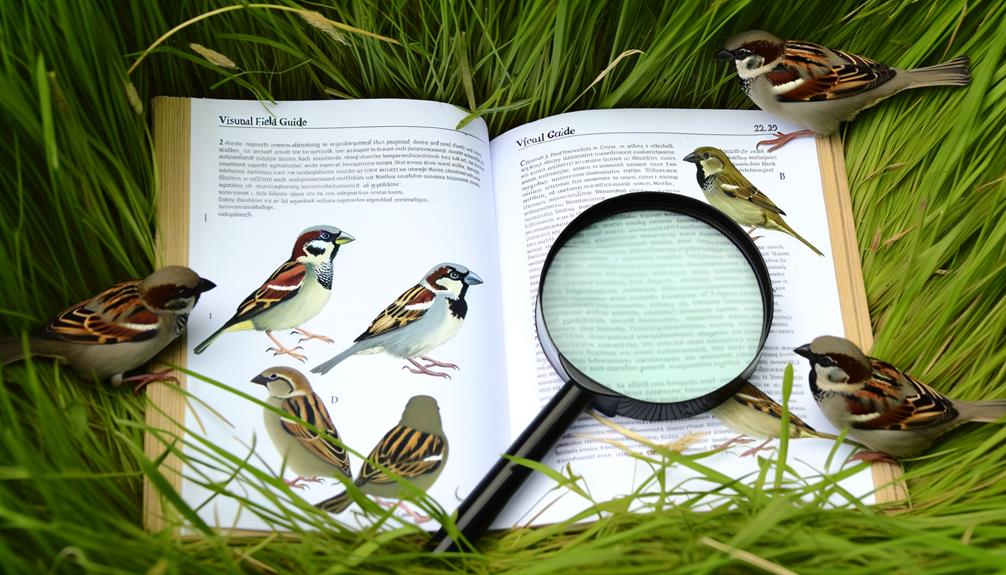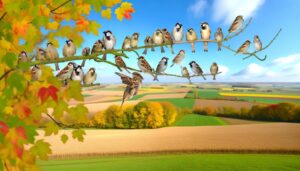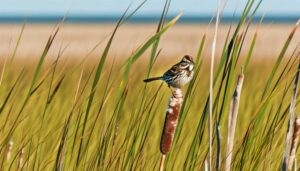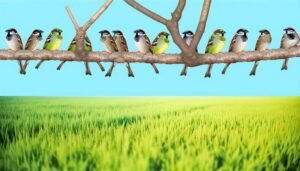Field Guide: 10 Essential Tips for Keying Out Sparrows
Keying out sparrows involves carefully observing distinctive characteristics. Sparrows, compact birds with conical beaks, present earth-toned plumage for camouflaging.
Their specific calls, varying from simple chirps to complex tunes, are significant clues for identification. Varied, these birds thrive in diverse habitats, from woodlands to urban landscapes.
Observing nest-building patterns and understanding diet shifts provide further identification cues. Attention to age-specific and gender-specific plumage helps distinguish between different sparrow species.
By focusing on these aspects, one can effectively key out these ubiquitous birds. Increasing knowledge in these areas can further enhance the understanding of this fascinating avian group.

Key Takeaways
- Pay attention to distinctive features like plumage patterns, beak shape, and size for accurate sparrow identification.
- Sparrows inhabit diverse habitats including forests, wetlands, urban areas, and farmlands; habitat knowledge aids in locating them.
- Sparrow calls, ranging from simple chirps to complex melodies, can provide crucial information for species identification.
- Observe nesting patterns and materials used for nest building, as these can vary based on species and habitat conditions.
- Male and female sparrows exhibit different plumage patterns; also, coloration evolves over time, reflecting sex and age.
Understanding Sparrow Basics
To fully appreciate the process of keying out sparrows, one must first grasp the essential characteristics that define these small, common birds. Sparrows are passerine birds, typically small in size with strong, conical beaks adapted for seed consumption. They're characterized by dull, earth-toned plumage that aids in camouflage against predators.
Their wings are short, enabling quick, agile flight, and their tails are usually long and narrow. Sparrows are mainly ground feeders, evidenced by their robust legs and feet. Vocalization plays a critical role in sparrow behavior, with a diverse range of calls and songs used for communication.
Understanding these fundamental attributes provides a solid grounding for the further exploration of individual sparrow species' identification, comprehending their distinct variations.
Sparrow Species: A Quick Overview
There exists a wide range of sparrow species, each boasting distinct features that facilitate their identification. These species, often characterized by their unique plumage, calls, and size, inhabit a broad spectrum of habitats, and exhibit diverse behavioral patterns.
A thorough understanding of these aspects is essential for accurate identification and further ornithological studies.
Identifying Sparrow Species
Drawing upon years of ornithological research, we've found that identifying sparrow species can be a nuanced task, as their size, plumage, and song patterns vary dramatically between each species.
The American Tree Sparrow, for instance, is distinguished by its bicolored bill and rusty cap, while the Black-throated Sparrow appears strikingly different with its black and white facial markings.
Further, the Song Sparrow's melodious tune helps affirm its identity in the field. Even within a species, variation can occur due to factors like age or season.
For instance, the Chipping Sparrow's breeding plumage is a stark contrast to its non-breeding appearance. Such variability calls for careful observation, and a keen ear, to accurately identify these feathered creatures.
Sparrow Habitats & Behavior
Amid diverse landscapes, from bustling city parks to tranquil forests, sparrows exhibit a wide range of behaviors and adapt to an array of habitats, making them an intriguing subject for ornithologists worldwide.
- Urban Adaptability: Sparrows thrive in cityscapes, taking advantage of human activity. They're often seen foraging for food in park areas or nesting in building crevices.
- Forest Dwellers: Some species prefer dense woodlands where they nest in tree cavities or shrubs, camouflaging themselves from predators.
- Migration Patterns: Sparrows are known for their seasonal migration, a behavior influenced by food availability and temperature changes.
Identifying Sparrow Calls
The complex melodies and chirps of sparrows aren't simply random sounds, but rather a coded language that requires careful observation for accurate identification.
Decoding sparrow songs involves an intricate examination of tempo, pitch, and rhythm, providing valuable insight into species identification and behavior.
Acknowledging the variations within sparrow calls, one must give attention to the subtle nuances, as even minor differences can distinguish one species from another.
Decoding Sparrow Songs
Bird enthusiasts often find that accurately identifying sparrow calls, each unique and multifaceted, provides valuable insights into the behavior and communication patterns of these ubiquitous birds.
Decoding these songs requires an understanding of three key factors:
- Frequency: The pitch of a sparrow's call varies, allowing for differentiation between species.
- Length: Some calls are brief chirps, while others are continuous trills; duration can be a distinguishing factor.
- Pattern: The rhythmic arrangement of a sparrow's call often indicates its intent, whether it's a mating call or a warning.
Sparrow Call Variations
In identifying sparrow calls, one must note that variations aren't only species-specific, but they can also reflect the bird's emotional state, time of day, and environmental factors.
For instance, the song sparrow's melodious trill varies in pitch and rhythm, signaling alarm, territory defense, or courtship. The chipping sparrow's repetitive chip, although monotonous, changes in intensity during different activities.
Environmental factors like temperature and wind speed can affect call clarity and volume. Morning and evening calls often differ, reflecting the bird's energy levels and vigilance.
Recognizing these variations offers valuable insights into sparrow behavior and ecology. Careful listening and observation, paired with knowledge of species-specific calls, enable accurate identification and deeper understanding of these fascinating birds.
Recognizing Sparrow Habitat Preferences
Surprisingly diverse, sparrow habitat preferences range from dense forests and marshy wetlands to urban gardens and farmlands.
Experts have identified three key factors that influence these preferences:
- Food Availability: Sparrows are primarily seed-eaters, but they'll also consume insects and fruits. Habitats that provide a consistent supply of these foods are highly favored.
- Nesting Sites: Sparrows prefer areas that offer ample nesting opportunities. This could be anything from tree cavities in forests, to shrubs in grasslands, and even man-made structures in urban areas.
- Predation Risk: Sparrows select habitats with low predation risk. They're more likely to inhabit areas with dense vegetation cover, providing protection from predators.
Understanding these habitat preferences, birdwatchers can better predict where to find these fascinating creatures.
Key Features of Sparrow Anatomy
While they may appear small and unassuming at first glance, sparrows actually have a unique anatomy with features specifically adapted for their seed-eating lifestyle. They possess a robust, conical beak that's perfect for cracking open seeds.
Their compact body size allows for efficient maneuvering through dense vegetation. Sparrows have strong leg muscles and sharp claws, ideal for ground foraging. Their wings, though short, are powerful and allow for agile flight.
A sparrow's plumage varies by species, yet their brown, gray, and white hues often provide effective camouflage. Their eyes, placed on the sides of their head, facilitate a wide field of vision for spotting predators.
These anatomical features, well-suited for survival, make the humble sparrow a fascinating study.
Sparrow Behavior and Traits
In the study of Sparrow Behavior and Traits, one must first examine their social habits, which are characterized by complex flock dynamics and intricate communication systems.
A key component of these communication systems are Sparrow calls, unique auditory signals used for a variety of purposes, from attracting mates to alerting others of potential threats.
Additionally, understanding Sparrow nesting patterns can provide insights into their reproductive strategies, seasonal migrations, and adaptations to various environments.
Sparrow Social Habits
Sparrows, known for their gregarious nature, typically form large, noisy flocks, showcasing a complex social structure that's fascinating to observe. Key elements of their social habits include:
- Hierarchy: Sparrows establish a pecking order, with dominant males usually occupying the highest ranks. They fiercely defend their status through physical displays and confrontations.
- Cooperation: Within flocks, sparrows work together in activities like foraging, providing mutual protection against predators, and sharing valuable information about food sources.
- Breeding Behavior: Male sparrows attract mates by singing and displaying their plumage, while females select the most appealing partners.
Such intricate dynamics exemplify the sparrows' remarkable adaptability, enabling them to thrive in diverse habitats worldwide. Understanding their social habits provides invaluable insights into their behavior and survival strategies.
Identifying Sparrow Calls
Echoing through the air, the distinct calls of sparrows serve as a complex language, revealing a wealth of information about these intriguing birds. These calls, which range from simple chirps to intricate melodies, aren't just random sounds. They're the sparrows' way of communicating essential information – warnings, mate attraction, and territorial assertions.
A rapid series of chips often signals alarm, while a softer, more melodious tune is usually a courtship call. Recognizing these calls requires careful listening and a keen ear for detail. It's a skill that requires patience and practice. But once mastered, it opens up a whole new level of understanding about the behavior and traits of these common yet mesmerizing creatures.
Sparrow Nesting Patterns
Just as their vocalizations reveal much about sparrows, so too do their nesting patterns offer insights into their behavior and unique traits.
Observations reveal a few commonalities:
- Site Selection: Sparrows often choose semi-covered areas for nest building. This could be in dense vegetation, under eaves, or inside tree cavities.
- Material Usage: Sparrows generally use grasses, twigs, and leaves for nest construction. These materials provide both structure and insulation.
- Clutch Size: Typically, sparrows lay between 3-5 eggs per clutch. This number may vary depending on the species and habitat conditions.
Distinguishing Sparrow Plumage Patterns
While one might initially struggle to identify various species of sparrows, focusing on their unique plumage patterns can greatly simplify the process. Sparrows sport a wide range of intricate feather designs, which, upon close observation, serve as reliable identification markers.
For instance, the Chipping Sparrow's stark, rufous cap contrasts with its crisp, grey underparts, while the Song Sparrow is recognizable by its heavy, dark streaking and central spot. On the other hand, the White-throated Sparrow is notable for its bold black and white head stripes.
It's crucial to note, though, that these patterns aren't always consistent across genders or age groups. Hence, keen attention to detail is essential in correctly distinguishing between these delicate avian species.
Seasonal Changes in Sparrows
Observing the seasonal changes in sparrows, one can't help but notice how these small birds adapt their behavior, diet, and even their distinctive plumage to the shifting weather patterns. Here are three key seasonal changes:
- Behavioral Changes: Sparrows become more sociable in the winter, gathering in flocks for warmth and protection. In contrast, they're more solitary during the breeding season.
- Dietary Shifts: During summer months, sparrows primarily consume insects. As winter approaches, they switch to a diet of seeds and grains.
- Plumage Alterations: Sparrows undergo a complete molt in late summer, replacing worn-out feathers. This results in a more subdued winter plumage, which helps them blend into their environment and conserve energy.
These adaptations showcase the remarkable resilience of sparrows to environmental changes.
Sex and Age Differences in Sparrows
How do sparrows differ in sex and age?
Observations reveal that male and female sparrows present distinct plumage patterns. Males typically flaunt bolder, more colorful markings while females commonly exhibit muted, brownish hues. This sexual dimorphism aids in attracting mates and hiding from predators.
Age, too, brings about changes. Juvenile sparrows often have softer, fluffier plumage compared to adults. Their coloration evolves over time, gradually acquiring the characteristic hues of their sex.
Regarding size, adults are generally larger, though size variability can occur within the same age group. Beak shape and color can also indicate age, with younger sparrows having shorter, duller beaks.
It's a nuanced world, this sparrow society, and each slight difference can tell a story of sex and age.
Sparrow Observation Tips
Birdwatching enthusiasts can enhance their sparrow-spotting endeavors by following a few practical tips. Recognizing sparrows requires keen attention to detail and a thorough understanding of their habitats, behaviors, and distinctive features.
- Habitat Recognition: Sparrows often reside in specific environments. Look for these birds in grasslands, wetlands, or urban areas.
- Behavioral Patterns: Sparrows are generally social birds. They're often seen in flocks, especially during non-breeding season, feeding on the ground or in lower vegetation.
- Distinctive Features: Pay attention to the bird's plumage patterns, size, and beak shape. Sparrows typically have a stout body with a rounded head, short tail, and a sturdy beak.
Popular Sparrow Species Profiles
Numerous sparrow species captivate bird enthusiasts worldwide, each boasting distinct features and behaviors that set them apart in the avian kingdom. Key among these are the House Sparrow, the Song Sparrow, and the White-throated Sparrow, all widely recognized and observed.
For a detailed comparison, consider this table:
| Species | Distinctive Features | Habitats |
|---|---|---|
| House Sparrow | Stout body, grayish-brown plumage | Urban and suburban areas |
| Song Sparrow | Stout body, streaked brown plumage | Marshes, fields, backyards |
| White-throated Sparrow | White throat, yellow lores, striped head | Forests, shrublands |
Each species' unique characteristics make them fascinating subjects, promoting a deeper appreciation for this small, often overlooked bird. Through careful observation, one can discover a world of diversity within the sparrow family.
Conservation Efforts for Sparrows
Despite their abundance and familiarity, sparrows are facing significant threats, making conservation efforts essential for their survival. Habitat loss, pollution, and climate change are the primary culprits.
In response, scientists and conservationists are implementing several strategies:
- Habitat Restoration: They're restoring and preserving native habitats, essential for sparrows' nesting and feeding.
- Pollution Control: They're advocating for stricter pollution controls to guarantee cleaner environments for these birds.
- Climate Change Mitigation: They're pushing for policies that address climate change, which impacts sparrow migration and breeding patterns.
Such efforts, while challenging, are necessary to ensure the continued survival of sparrows. It's a clear reminder of our responsibility to protect the environment and its diverse inhabitants.
Conclusion
Despite their diminutive size, sparrows are a fascinating species with over 140 different types worldwide.
Astoundingly, over 6 million sparrows were recorded in the UK alone in 2020, highlighting their widespread presence.
By understanding their calls, habitat preferences, and anatomy, one can better appreciate these ubiquitous birds.
Their conservation is essential as they play a critical role in maintaining our ecosystem's balance.
Let's continue observing, studying, and protecting these intriguing creatures.






